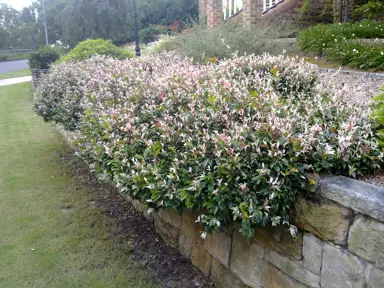
The Plant Company grows, sells, and ships Corylus trees throughout NZ. We pride ourselves on producing high quality plants and seeing the joy from our customers when they receive them. We do hope you enjoy them and support this NZ business that is passionate about plants.
Corylus avellana Contorta, commonly known as the Corkscrew Hazel or Harry Lauder's Walking Stick, is a deciduous tree grown for its contorted stems...
Corylus avellana, commonly known as the Hazelnut tree or Filbert tree, is a deciduous tree grown primarily for its nuts. The nuts result from flowers...
Corylus colurna, commonly known as the Turkish Hazel or Turkish Filbert, is a deciduous tree grown for its aesthetic value and nuts. The foliage on...
Corylus maxima Purpurea, commonly known as the Purple-Leaved Filbert tree, is grown for its attractive foliage and interesting catkins. This...
Growing Filbert trees in your garden delivers a vast range of benefits:
We have the largest variety of Hazelnut trees, and the right one for your space. Our Filbert trees have been selected to thrive in NZ’s climate, and we only stock the highest quality plants, sourcing them locally, and from NZ’s leading nurseries. Each plant is packed and transported with extreme care, ensuring it arrives to you in the same condition it was in when it left the nursery. If you are wanting to buy a Hazelnut tree, shop with confidence from the best in the industry.
Corylus are commonly known as hazels, and are a genus of deciduous shrubs and trees that are native to temperate regions of the Northern Hemisphere. They are known for their edible nuts (Hazelnuts), which are a good source of protein, fibre, and healthy fats.
Hazels are relatively easy to grow and can tolerate a wide range of conditions, but there are a few things to get right:
The nuts of Corylus avellana, also known as hazelnuts, are a popular food item that can be eaten raw, roasted, or ground into a paste. Hazelnuts are a good source of protein, fibre, and healthy fats. They also contain vitamins and minerals, such as vitamin E, magnesium, and manganese. They can be eaten on their own or used in a variety of recipes, such as cookies, cakes, and pies, or to make hazelnut milk and hazelnut butter.
The leaves and bark of Corylus trees have also been used in traditional medicine. However, it is important to be aware that Corylus leaves and bark can be toxic if consumed in large quantities.
Yes, you can grow hazelnuts in New Zealand. They are a relatively new crop in New Zealand, but they are well-suited to the country's climate and soils. Hazelnuts can be grown almost anywhere across NZ.
The best hazelnut tree for New Zealand is Whiteheart. It is a New Zealand-developed cultivar that is well-suited to the country's climate and soils. It produces high yields of large, sweet nuts, and is relatively resistant to pests and diseases.
Other good hazelnut varieties include:
You can eat hazelnuts straight from the tree, provided they are ripe. Hazelnuts are ripe when their shells are hard and brown, and the husks have split open. To harvest hazelnuts, simply shake the tree and collect the nuts that autumn to the ground. The shells are quite hard, so you will need to use a nutcracker or other tool to crack them open. Once the shell is cracked open, you can remove the kernel and eat it raw.
Raw hazelnuts have a slightly bitter taste, but they are still edible. Roasting hazelnuts will enhance their flavour. Here are some tips for roasting hazelnuts:
Both "filbert" and "hazelnut" refer to the same nut, but the term "hazelnut" has become more dominant for a few reasons:
Historical Differences:
Shifting Usage:
Current Trends:
So, while "filbert" isn't entirely wrong, "hazelnut" is the preferred term nowadays, thanks to historical developments, marketing efforts, and international standardization.
Filbert trees, also known as hazelnuts, can vary in size depending on several factors, including:
Species:
No, "hazel tree" and "hazelnut tree" are not exactly the same, but they are very closely related:
So, all hazelnut trees are hazel trees, but not all hazel trees are hazelnut trees. Some hazel species, like the Turkish hazel, are primarily ornamental and their nuts are not typically eaten.
There's no one-size-fits-all answer to how many hazelnuts you should eat per day, as it depends on several factors:
Your overall diet: If you're trying to maintain a healthy weight, a moderate serving of hazelnuts (around 25-30 grams or 1-2 ounces) is a good starting point. This is roughly equivalent to 15-20 hazelnuts. However, if you're already eating a lot of other high-calorie foods, you might need to adjust your hazelnut intake accordingly.
Your individual calorie needs: Depending on your age, gender, activity level, and other factors, your daily calorie needs will vary. If you're unsure, consult a registered dietitian or healthcare professional to determine your individual needs and how hazelnuts might fit into your diet.
Your health goals: If you're trying to lose weight, manage diabetes, or improve heart health, the amount of hazelnuts you eat may need to be adjusted based on your specific goals and any medical advice you've received.
Here are some additional things to keep in mind:
Whether you need assistance finding the plant you’re looking for or you simply want to know more about who we are and what we do, we invite you to get in touch with us today. A member of The Plant Company team will get back in touch as soon as possible.


